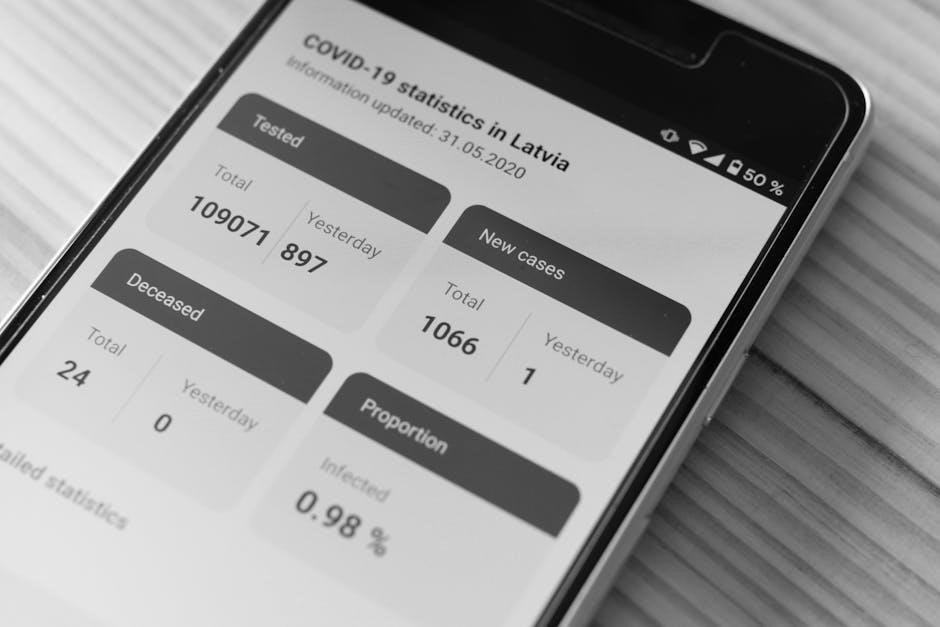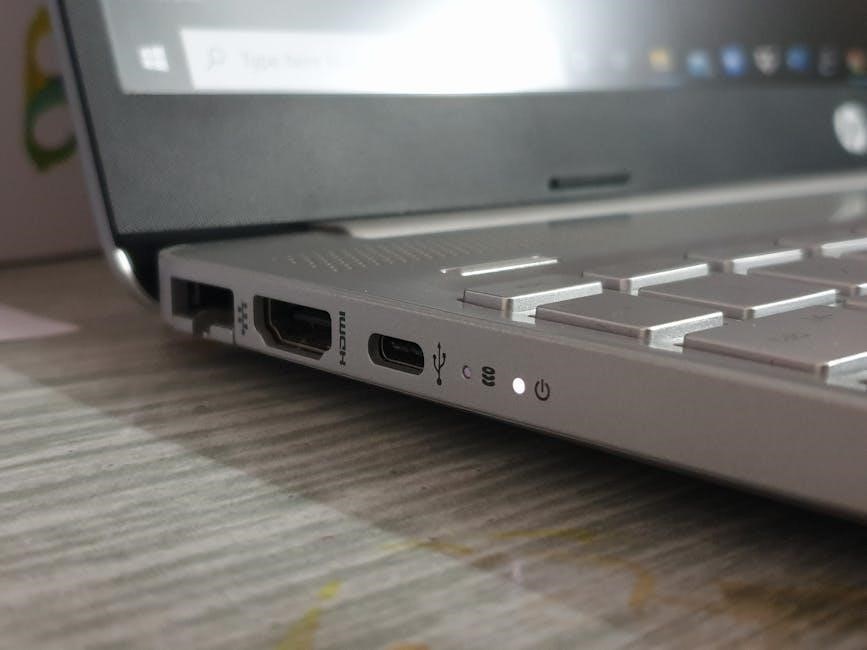Network port numbers are essential for communication in IP networks․ IANA assigns these ports, enabling services like HTTP and FTP to function․ They are crucial for protocol operations and data transmission efficiency․
1․1 Definition and Purpose of Port Numbers
Port numbers are 16-bit integers used to identify specific communication channels in computer networking․ They range from 0 to 65535 and are essential for distinguishing between different applications or services running on a device․ The primary purpose of port numbers is to enable efficient data transmission by providing a way to address specific processes or services within a system․ For example, HTTP traffic typically uses port 80, while HTTPS uses port 443․ The Internet Assigned Numbers Authority (IANA) is responsible for assigning and managing port numbers, ensuring standardized communication across networks․ Ports are crucial for protocol operations, allowing devices to understand how to route data to the correct application․ This standardized system enables seamless communication and resource allocation in IP networks․

1․2 Importance of Port Numbers in Networking
Port numbers play a critical role in enabling efficient and organized communication within computer networks․ They allow multiple applications to run simultaneously on a single device by providing unique identifiers for each service or process․ This differentiation ensures that data is routed to the correct application, preventing conflicts and improving overall network performance․ Port numbers also facilitate protocol efficiency, as they enable protocols like TCP and UDP to identify and direct traffic accurately․ The standardized management of ports by IANA ensures consistency across networks, making it easier for devices to communicate; Additionally, ports are vital for security, as firewalls often rely on them to control and filter traffic․ Without port numbers, managing and securing network communications would be highly challenging, making them a foundational element of modern networking infrastructure․
1․3 Overview of IANA and Port Number Assignments
The Internet Assigned Numbers Authority (IANA) is responsible for managing the Service Name and Transport Protocol Port Number Registry․ This registry ensures that port numbers are uniquely assigned to specific services and protocols, preventing conflicts and promoting consistency across the internet․ IANA categorizes ports into three ranges: Well-Known Ports (0-1023), Registered Ports (1024-49151), and Dynamic/Private Ports (49152-65535)․ The assignment process involves reviewing requests to ensure that ports are allocated fairly and transparently․ IANA publishes official assignments in the service-names-port-numbers․xml file, which is regularly updated․ This system guarantees that critical services like HTTP, FTP, and DNS can operate reliably, while also accommodating proprietary and emerging applications․ IANA’s role is essential for maintaining the integrity and functionality of global network communications․

Classification of Port Numbers
Port numbers are categorized into three ranges: Well-Known Ports (0-1023), Registered Ports (1024-49151), and Dynamic/Private Ports (49152-65535)․ Each range serves distinct purposes in network communication and service allocation․
2․1 Well-Known Ports (0-1023)
Well-Known Ports, ranging from 0 to 1023, are standardized by the Internet Assigned Numbers Authority (IANA) for common network services․ These ports are reserved for system-level services and widely recognized protocols․ Examples include HTTP (Port 80), HTTPS (Port 443), FTP (Ports 20 and 21), and SMTP (Port 25)․ They are essential for enabling standard communication protocols across the internet․ Well-Known Ports are typically used by system processes and are a critical part of network infrastructure․ Their predefined assignments ensure consistency and interoperability across different devices and platforms․ This range is strictly managed by IANA to maintain order and prevent conflicts in network communication․ Well-Known Ports are fundamental for establishing reliable connections and facilitating essential services in IP networks․
2․2 Registered Ports (1024-49151)
Registered Ports, spanning from 1024 to 49151, are assigned by the Internet Assigned Numbers Authority (IANA) for specific services and applications․ These ports are used by a wide range of programs and protocols, offering a balance between standardization and flexibility․ Examples include MySQL (Port 3306), Microsoft SQL Server (Port 1433), and Oracle (Port 1521)․ This range allows organizations and developers to create consistent network configurations while avoiding conflicts with Well-Known Ports․ Registered Ports are essential for enabling diverse applications and services to operate efficiently across networks․ They are documented by IANA to ensure clarity and prevent duplication, making them a vital part of modern networking infrastructure․ This range is widely used for both public and private applications, supporting the diverse needs of network communication․
2․3 Dynamic/Private Ports (49152-65535)
Dynamic or Private Ports, ranging from 49152 to 65535, are not officially assigned by IANA for specific services․ These ports are typically used dynamically by applications for temporary or client-specific connections․ They provide flexibility for systems to allocate ports as needed, avoiding conflicts with standardized services․ For example, MySQL’s Extended Interface (Port 33060) operates within this range․ Dynamic Ports are often used for custom applications, internal communication, or client-server interactions where a fixed port is unnecessary․ This range allows systems to manage multiple simultaneous connections efficiently without relying on predefined assignments․ While not standardized, these ports are crucial for enabling diverse and adaptive network communication, supporting the dynamic nature of modern applications and services․

Key Port Numbers and Their Applications
Essential ports like HTTP (80), HTTPS (443), FTP (20, 21), SMTP (25), and DNS (53) enable critical network communication․ These ports are assigned by IANA for specific services, ensuring reliable data transmission and protocol functionality․
3․1 HTTP (Port 80) and HTTPS (Port 443)
Ports 80 and 443 are fundamental for web communication․ HTTP (Port 80) handles unencrypted data transfer for web traffic, while HTTPS (Port 443) secures data using SSL/TLS encryption․ Both ports are assigned by IANA and are essential for web servers to deliver content․ HTTP is used for standard web browsing, while HTTPS is preferred for secure transactions, such as e-commerce and login pages․ These ports ensure that data is transmitted efficiently and securely between clients and servers, making them critical for online communication․ Their standardized use guarantees compatibility across devices and networks, enabling seamless access to web resources globally․
3․2 FTP (Port 20 and 21)
Ports 20 and 21 are designated for the File Transfer Protocol (FTP), a standard network protocol used for transferring files between a client and a server․ Port 20 is typically used for data transfer, while Port 21 handles control commands, such as initiating and managing connections․ FTP is widely used for sharing and downloading files over networks․ These ports are officially assigned by IANA and are essential for FTP services to function properly․ FTP supports both active and passive modes, with active mode requiring additional configuration․ These ports are critical for reliable file transfers and are commonly used in scenarios where large files or directories need to be shared securely․ Their standardized use ensures compatibility across different systems and networks․
3․3 SMTP (Port 25)
Port 25 is designated for the Simple Mail Transfer Protocol (SMTP), a protocol used for sending and relaying email messages between email servers and clients․ SMTP relies on Port 25 to establish connections and transfer messages․ This port is essential for email delivery, enabling communication between mail transfer agents (MTAs) and mail delivery systems․ Port 25 is officially assigned by IANA and is a standard for email transmission․ While it is commonly used for outgoing emails, some systems may use alternative ports like 587 or 465 for specific configurations․ SMTP operates using a command-and-response model, ensuring reliable message delivery․ Security measures, such as encryption with TLS, are often applied to enhance email communication․ Port 25 remains critical for global email infrastructure, facilitating the exchange of messages across networks and systems․
3․4 DNS (Port 53)
Port 53 is designated for the Domain Name System (DNS), a critical service that translates human-readable domain names into IP addresses․ DNS operates over both TCP and UDP protocols, with Port 53 being the standard for both․ This port is essential for resolving domain names to IP addresses, enabling communication between devices on a network․ Port 53 is officially assigned by IANA and is a fundamental component of internet infrastructure․ DNS queries and responses are typically sent over Port 53, ensuring efficient name resolution․ While UDP is commonly used for DNS queries due to its speed, TCP may be employed for larger responses or specific configurations․ Port 53 is vital for maintaining connectivity and accessibility across the internet, making it a cornerstone of network communication and online services․
3․5 SSH (Port 22)
Port 22 is reserved for the Secure Shell (SSH) protocol, a cryptographic network protocol used for secure remote access to a device or network․ SSH provides a secure channel for data exchange, ensuring confidentiality and integrity through encryption․ It is widely used for secure system administration, file transfers, and tunneling․ Port 22 is the default port for SSH connections, officially assigned by IANA․ SSH replaces insecure protocols like Telnet and FTP, offering robust security features such as public-key authentication and encryption․ This port is critical for secure communication in enterprise environments, enabling administrators to manage servers and devices safely․ Port 22 is a cornerstone of secure network access, protecting sensitive data from unauthorized access and eavesdropping․

3․6 Telnet (Port 23)
Port 23 is assigned to the Telnet protocol, a standard for remote terminal connections over IP networks․ Telnet enables users to access and manage remote devices, but it is insecure as data is transmitted in plain text․ This makes it vulnerable to eavesdropping and unauthorized access․ Despite its lack of security, Telnet remains useful for legacy systems or simple testing․ It is part of the well-known ports (0-1023) and is officially assigned by IANA․ Telnet has largely been replaced by SSH (Secure Shell) for secure remote access․ However, it is still supported in many systems for backward compatibility․ Port 23 is a reminder of earlier networking protocols, highlighting the importance of security advancements in modern communication․
3․7 SNMP (Port 161 and 162)
SNMP (Simple Network Management Protocol) operates on ports 161 and 162, playing a crucial role in network management․ Port 161 is used by SNMP agents to receive requests from managers, while Port 162 is dedicated to sending traps from agents to managers․ These ports enable monitoring, configuration, and fault detection in network devices․ SNMP is standardized by the Internet Engineering Task Force (IETF) and is widely used for managing routers, switches, and other network equipment․ The protocol supports three versions, with Version 3 being the most secure․ Both ports are officially assigned by IANA and are essential for maintaining network performance and security․ They allow administrators to collect data and receive alerts, ensuring efficient network operations and troubleshooting․
3․8 NTP (Port 123)
NTP (Network Time Protocol) operates on port 123, facilitating precise time synchronization across network devices․ It ensures clocks remain accurate by querying NTP servers and adjusting local time accordingly․ Port 123 is officially assigned by IANA for this purpose․ NTP is essential for maintaining consistency in logging, authentication, and time-stamping processes․ It uses the UDP protocol due to its efficiency in transmitting time data without requiring connection-oriented communication․ NTP servers are organized in a hierarchical structure, with higher-tier servers synchronizing directly with atomic clocks․ This protocol is critical for systems requiring high precision, such as financial transactions and scientific research․ By leveraging port 123, NTP ensures devices worldwide maintain synchronized time, reducing errors and improving coordination across networks․
3․9 RDP (Port 3389)
Remote Desktop Protocol (RDP) operates on port 3389, enabling remote access to Windows-based systems․ RDP allows users to connect to a remote computer as if they were sitting in front of it․ This port is officially assigned by IANA for Microsoft’s Remote Desktop Services․ RDP uses the TCP protocol to establish reliable, connection-oriented communication․ It is widely used for administrative tasks, remote support, and accessing virtual desktops․ While convenient, RDP can be a target for cyberattacks if not properly secured․ Best practices include using strong passwords, enabling encryption, and restricting access to trusted networks; Port 3389 is essential for organizations relying on remote work and centralized management, making it a critical component of modern IT infrastructure․
3․10 MySQL (Port 3306)
MySQL uses port 3306 for its default communication channel․ MySQL is a popular relational database management system that relies on this port for client-server connections․ IANA has officially assigned port 3306 for MySQL services․ The port is used by applications to interact with MySQL databases, enabling operations like querying, updating, and managing data․ It supports both TCP and UDP protocols, though TCP is predominantly used for its reliability․ MySQL also uses other ports, such as 33060 for its extended interface and 6446 for the MySQL Proxy․ Port 3306 is essential for database administrators and developers, as it facilitates remote access and management of MySQL databases․ Proper configuration and security measures are crucial to prevent unauthorized access and ensure data integrity․
3․11 Microsoft SQL Server (Port 1433)

Microsoft SQL Server uses port 1433 for its default communication channel; IANA has officially assigned this port for SQL Server services․ The port is primarily used for client-server communication over TCP/IP, enabling applications to interact with SQL Server databases․ Port 1433 is essential for database administrators and developers, as it facilitates remote access and management of SQL Server instances․ While it is the default port, administrators can configure SQL Server to use a different port for security purposes․ Additionally, SQL Server may use other ports for specific features, such as port 1434 for the SQL Server Browser service․ Proper configuration and security measures are crucial to protect this port from unauthorized access and ensure reliable database operations․
3․12 Oracle (Port 1521)
Port 1521 is the default port for Oracle database communication․ It is primarily used by the Oracle TNS (Transparent Network Substrate) listener to facilitate client connections to the database․ This port enables communication between Oracle client applications and the database server, allowing for queries, data retrieval, and other database operations․ While port 1521 is the standard, Oracle allows administrators to configure it to use a different port for security or organizational reasons․ Proper configuration of this port is critical for ensuring database accessibility and performance․ Additionally, securing this port is essential to prevent unauthorized access and potential vulnerabilities․ Administrators often monitor this port for traffic and ensure it is properly encrypted when used over public networks․ This port is a key component in Oracle’s network architecture for reliable database connectivity․

3․13 LDAP (Port 389)
Port 389 is the default port for the Lightweight Directory Access Protocol (LDAP), a protocol used for accessing and managing directory information services․ LDAP is commonly used for authentication, authorization, and directory services in networks․ Port 389 facilitates communication between LDAP clients and servers, enabling users to query and update directory information․ This port is assigned by IANA and is widely used in enterprise environments for services like Active Directory․ While port 389 is the standard, administrators can configure LDAP to use alternative ports for specific requirements․ Securing this port is critical, as it often contains sensitive user and organizational data․ Encrypting LDAP traffic using LDAPS (LDAP over SSL/TLS) on port 636 is recommended for secure communication․ Proper configuration and monitoring of port 389 are essential for maintaining directory service functionality and security․

3․14 LDAPS (Port 636)
Port 636 is the default port for LDAPS (LDAP over SSL/TLS), a secure version of the Lightweight Directory Access Protocol․ LDAPS encrypts LDAP traffic using SSL/TLS, ensuring confidentiality and integrity of directory data․ This port is assigned by IANA and is critical for secure communication in enterprise environments․ LDAPS is often used for authentication and directory services, protecting sensitive information like user credentials and organizational data․ Unlike LDAP on port 389, LDAPS provides end-to-end encryption, making it essential for environments requiring high security․ Administrators frequently use LDAPS to comply with security policies and regulations․ Proper configuration of SSL/TLS certificates is necessary for LDAPS to function correctly․ This port is a cornerstone of secure directory services, enabling trusted communication between clients and servers in modern networks․
3․15 SMB (Port 445)

Port 445 is associated with the Server Message Block (SMB) protocol, used for file and printer sharing in Windows environments․ It enables network drives and directory access, facilitating resource sharing across local networks․ SMB over TCP/IP uses port 445, replacing the earlier reliance on NetBIOS․ This port is essential for Windows-based systems but is also supported by other operating systems․ SMB has evolved through versions like SMBv1, SMBv2, and SMBv3, with the latter introducing enhanced security features․ Port 445 is assigned by IANA and is critical for seamless communication in enterprise and home networks․ While it is widely used, it can be a target for malicious activities, making proper security configurations vital․ This port remains a cornerstone of network resource sharing and collaboration․
3․16 DHCP (Port 67 and 68)
Ports 67 and 68 are reserved for the Dynamic Host Configuration Protocol (DHCP), a critical service for IP address assignment․ Port 67 is used by DHCP servers to listen for client requests, while port 68 is used by clients to receive IP address assignments․ DHCP simplifies network configuration by automatically assigning IP addresses, subnet masks, and default gateways․ This eliminates manual setup, reducing errors and saving time․ Ports 67 and 68 are essential for network operations, enabling devices to connect seamlessly․ They are standardized by IANA and widely used in both small and large networks․ Proper configuration of these ports ensures efficient network communication and resource allocation․ Their role is vital in maintaining dynamic IP address management, making them indispensable in modern networking environments․
3․17 TFTP (Port 69)
Port 69 is assigned to the Trivial File Transfer Protocol (TFTP), a simplified version of FTP for transferring files without authentication․ It uses UDP for connectionless communication, making it lightweight and efficient․ TFTP is commonly used for firmware updates, booting devices over a network, and transferring configuration files․ Unlike FTP, it lacks advanced features like user authentication or directory listings, focusing solely on basic file transfers․ Port 69 is officially assigned by IANA and is widely used in embedded systems and network devices․ Its simplicity makes it ideal for environments where minimal overhead is required․ However, the lack of security features means it should not be used for sensitive data․ TFTP remains a essential tool in network administration for specific use cases, ensuring reliable file transfers in lightweight scenarios․
3․18 POP3 (Port 110)
Port 110 is designated for the Post Office Protocol version 3 (POP3), a widely used email retrieval protocol․ POP3 enables clients to download emails from a mail server to a local device․ It operates using a simple “store-and-forward” model, where emails are removed from the server once downloaded․ POP3 is assigned by IANA and typically uses plaintext authentication, which can be insecure without additional security measures like SSL/TLS․ It is often compared to IMAP, but unlike IMAP, POP3 does not support syncing emails across multiple devices․ POP3 is commonly used for basic email retrieval in scenarios where simplicity and minimal server storage are prioritized․ Despite its lack of advanced features, it remains a popular choice for lightweight email clients and legacy systems․
3․19 IMAP (Port 143)
Port 143 is assigned to the Internet Message Access Protocol (IMAP), a protocol used for accessing and managing emails on a mail server․ Unlike POP3, IMAP enables two-way synchronization, allowing users to access and manage emails across multiple devices․ It supports features like folder management, search, and remote mailbox access․ IMAP is widely used for its flexibility and efficiency in modern email clients․ The protocol operates over TCP and is often secured with SSL/TLS on port 993․ IANA officially assigns port 143 for IMAP, making it a standard for email communication․ Its ability to maintain email state on the server makes it preferred for users needing consistent access to their emails across devices․ This protocol is essential for email clients seeking advanced synchronization and management capabilities․
3․20 IRC (Port 6667)
Port 6667 is commonly associated with Internet Relay Chat (IRC), a protocol enabling real-time text messaging and group discussions․ IRC is widely used for chat rooms and community interactions․ While not officially assigned by IANA, port 6667 has become the de facto standard for IRC connections due to its historical use․ The protocol supports various chat clients and servers, offering features like channel management and user authentication․ IRC is popular among open-source communities, developers, and gamers for collaborative discussions․ Although port 6667 is standard, some servers may use alternative ports for security or specific configurations․ IRC operates over TCP and is often secured with SSL/TLS on port 6697․ Its lightweight design and flexibility make it a enduring choice for text-based communication․
3․21 BitTorrent (Port 6881-6889)
Ports 6881-6889 are commonly used by the BitTorrent protocol for peer-to-peer file sharing․ These ports enable communication between clients and trackers, facilitating the distribution of large files across a decentralized network․ While not officially assigned by IANA, this range has become the de facto standard for BitTorrent traffic․ Users can configure their clients to use these ports for incoming connections, improving compatibility with other peers․ BitTorrent relies on these ports to establish efficient data transfer between participants․ The protocol supports both TCP and UDP for reliable and fast file sharing․ By using these ports, BitTorrent clients can connect to swarms and download or seed content effectively․ This port range is essential for the proper functioning of the BitTorrent network and its ability to handle large-scale file distribution․
3․22 SIP (Port 5060 and 5061)
The Session Initiation Protocol (SIP) uses ports 5060 and 5061 for managing voice and video calls over IP networks․ Port 5060 is typically used for UDP communications, while port 5061 is reserved for secure TLS connections․ SIP is essential for establishing, modifying, and terminating real-time communication sessions, such as VoIP calls․ These ports are standardized by IANA and are critical for enabling modern telephony and conferencing systems․ SIP supports features like call forwarding, conferencing, and messaging, making it a cornerstone of unified communications․ Proper configuration of these ports ensures seamless communication in VoIP infrastructures․ They are widely used in enterprise telephony systems and are fundamental to the operation of IP-based communication services․
3․23 RTP (Port 16384-32768)
Real-Time Transport Protocol (RTP) operates on ports 16384 to 32768, enabling real-time audio and video transmission over IP networks․ This range supports multiple simultaneous streams, ensuring efficient media delivery․ RTP is commonly used in VoIP, video conferencing, and streaming services․ It works alongside RTCP for session control and monitoring․ The protocol is standardized by the IETF and assigned by IANA․ RTP’s dynamic port range allows flexibility in handling diverse multimedia applications․ Proper configuration ensures high-quality, low-latency communication․ It is widely adopted in modern communication systems, making it indispensable for real-time media transmission․ This port range is crucial for maintaining seamless audio and video synchronization in various applications;

3․24 RTCP (Port 16385-32769)
Real-Time Transport Control Protocol (RTCP) operates on ports 16385 to 32769, providing control and monitoring for RTP sessions․ It transmits control packets, such as sender and receiver reports, to assess data transmission quality․ RTCP is essential for synchronization, bitrate adjustment, and session management․ It ensures efficient media delivery by monitoring packet loss and jitter․ RTCP ports are dynamically assigned, often in a contiguous range with RTP․ This protocol is critical for maintaining reliable real-time communication․ It is standardized by the IETF and assigned by IANA․ RTCP’s role in quality control makes it indispensable for streaming and conferencing applications․ Proper configuration ensures optimal performance in multimedia transmissions․ This port range supports the seamless operation of real-time communication systems․
